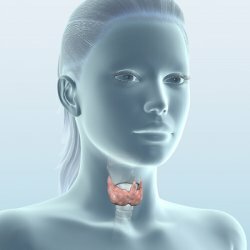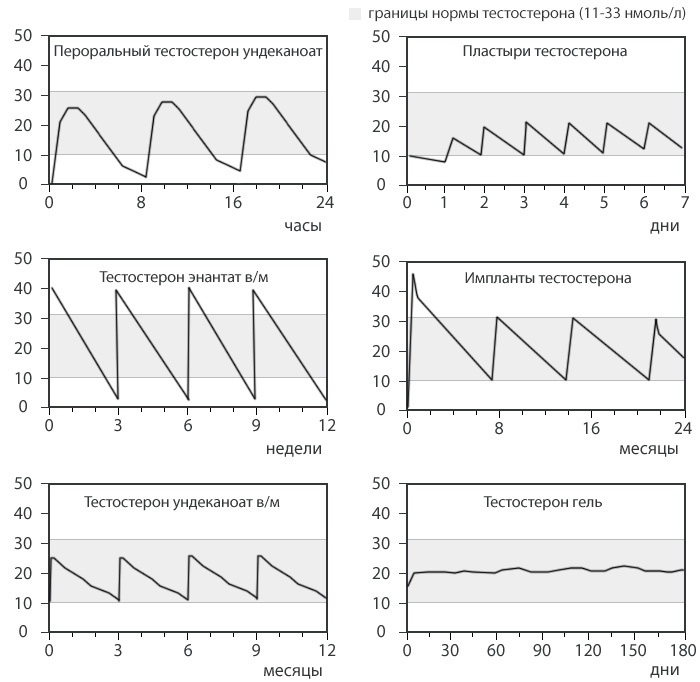How the thyroid gland works and how it works

Normally located thyroid gland is located between the thyroid cartilage and the jugular notch and usually has the shape of a butterfly whose wings are the lateral lobes of the gland, and the body - a strip of tissue between them( the isthmus of the gland) and a small pyramidal part extending from it to the top.
If you look at the tissue of the gland under a microscope, we will see that it consists of concentric circles of thyroid cells that surround closed cavities called follicles, in the center of which is a colloid containing thyroid hormones.
Thyroid hormone production begins with the activity of one of the brain regions - the hypothalamus, which produces a hormone called the releasing hormone. This hormone appears in another part of the brain - the pituitary gland, where the development of thyroid stimulating hormone( TSH) begins: TSH produced by the pituitary gland, enters the blood and is transferred to the thyroid gland, where it secures the production and release of the two hormones - thyroxine and triiodothyronine -Three( T3).
T3 is considered an active form of the hormone, and T4 is a prohormone that acquires activity only after conversion to T3.The transformation of T4 and T3 occurs not only in the thyroid gland, but also in other organs.
The regulation of thyroid hormone production is as follows:
- when the thyroid-stimulating hormone of the pituitary gland reaches the thyroid gland, it triggers 2 processes - the release of hormones in the thyroid gland and the production of hormones by the gland cells;
- hormones that enter the blood reach the pituitary gland;
- if the pituitary gland determines that the level of thyroid hormones is normal, it continues to produce the usual amount of TSH, if it finds that it is low - it increases the production of TSH, and if it is excessive, it reduces the production of TSH, that is, regulation is carried out according to the feedback principle.
How thyroid hormones
work Thyroid hormones show their activity in almost every organ and body cell.
Their actions can be divided into general and specific.
The general effect is that thyroid hormones cause cells to produce more enzymes, proteins and chemicals that enhance metabolic( metabolic) processes. The action of thyroid hormones on the body is sometimes compared with the addition of an enriched fuel mixture in the engine, which increases the number of revolutions.
The main level of metabolism, an indicator of the intensity of metabolic processes, can be increased by 60% or even 100% under the influence of thyroid hormones. The stronger the machine, the more it warms up. Similarly, with an excess of thyroid hormones, the body temperature rises, and if there is a lack of it, it is reduced. The more intensely the metabolic processes take place, the more incoming nutrients enter into energy, the less they remain in the body for the formation of tissues( muscle, fat).The body feels an increasing need for energy sources, you start to eat more, however, incoming food does not fill energy costs, and weight loss begins. Although sometimes people with excessive production of thyroid hormones manage to exceed the costs with a large amount of high-calorie food, and they can even be complete.
Our muscles also require thyroid hormones for full-time work. However, with excess intake of hormones, muscles are destroyed from excessive energy consumption, and their strength decreases, and the excitability of the nerves innervating the muscles increases and muscle tremor occurs.
There are products in which thyroid hormones are included in order to reduce body weight.
REMEMBER! When using thyroid hormones, you lose muscle tissue more than fat, so do not use thyroid hormones to lose weight.
In addition to proteins of the muscle tissue under the influence of hormones faster than other sources of energy - carbohydrates and proteins - are normally used.
Let us now consider the specific action of the thyroid hormones necessary for the normal functioning of the organs of the human body.
The heart needs a thyroxine to effectively perform the pumping function, which falls when the level of this hormone drops down to the development of heart failure.
On the contrary, with excess intake of hormones, the heart works too fast. And although in the beginning the heart muscle pumps a larger volume of blood, it soon becomes exhausted, and its strength decreases.
- Light. Since increased metabolism requires increased oxygen supply, breathing becomes rapid, but this does not always ensure sufficient oxygen supply.
Under the influence of excess thyroxine, the muscles of the breast and diaphragm are depleted.
- Gastrointestinal tract. Hormones are necessary for the muscles of the stomach and intestines to promote food, and when they are few, a person suffers from constipation.
- Skin, hair, nails. With an excess of thyroxine, blood circulation increases, and the skin becomes warm, and increased sweating makes it damp.
When the level of hormones decreases, the skin becomes dry and thickened, often flaking. Nails grow poorly, they are soft and easily broken. The hair becomes thinner and falls out.
- Activity of the brain. Excessive amount of hormones is accompanied by increased excitability and nervousness, and the lack - by depression and emotional dullness.
- Sexual function is performed fully only at a normal level of thyroid hormones.
Increase or decrease in their content leads to a violation of libido and potency in men and the menstrual cycle in women.
- Bones. Thyroid hormones contribute to the normal development of bone tissue. If in the early childhood the amount of hormones is not enough, the bones develop slowly, do not reach normal sizes, and the person remains a dwarf.
With an excess of thyroid hormones, bone loss increases. As a result, osteoporosis occurs, but this rarely leads to fractures of the bones.
Be Healthy!

